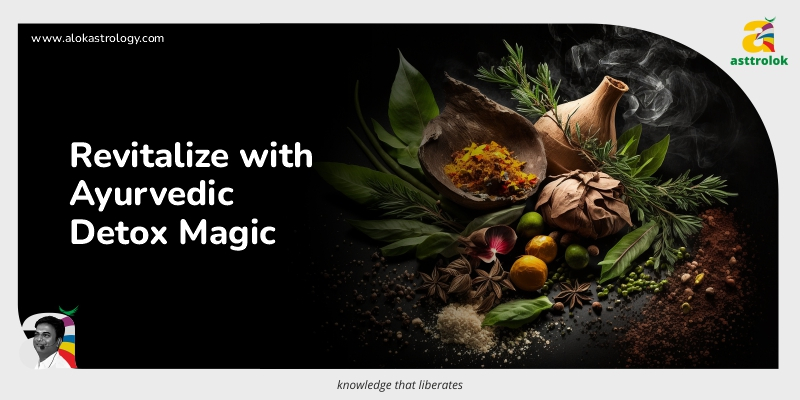In the hustle and bustle of modern life, our bodies often bear the brunt of stress, pollution, and unhealthy lifestyle choices. Ayurveda, the ancient Indian system of medicine, offers a holistic approach to detoxification, focusing on restoring balance and harmony within the body and mind. In this comprehensive guide, we explore the principles of Ayurvedic detox, providing insights into natural methods to cleanse and rejuvenate.
Learn more about Ayurvedic detox. Get an online astrology consultation by the world-renowned astrologer Mr. Alok Khandelwal
Understanding Ayurvedic Detox: A Holistic Approach
Ayurveda views detoxification as a means to eliminate accumulated toxins (ama) from the body, promoting optimal health and well-being. The process involves purifying the body’s tissues, enhancing digestion, and balancing the three doshas—Vata, Pitta, and Kapha. Here’s a closer look at the key aspects of Ayurvedic detox:
1. Dosha Assessment: Personalized Detoxification
Ayurveda recognizes that each individual is unique, with a distinct constitution. Before embarking on a detox journey, it’s crucial to identify your dominant dosha or combination of doshas. This personalized approach ensures that the detox plan aligns with your specific needs and imbalances.
2. Seasonal Alignment: Adapting to Nature’s Rhythms
Ayurveda emphasizes aligning detox practices with the seasons. As the body responds differently to environmental changes, seasonal detoxification helps optimize the body’s natural processes. Spring, for example, is considered an ideal time for cleansing, as it mirrors the rejuvenation happening in nature.
3. Ayurvedic Dietary Guidelines: Nourishing and Cleansing
Diet plays a pivotal role in Ayurvedic detox. Emphasize whole, seasonal foods that align with your dosha. A detox diet typically includes light, easily digestible foods such as steamed vegetables, whole grains, and detoxifying spices like turmeric and ginger. Stay hydrated with warm water or herbal teas to support the elimination of toxins.
4. Panchakarma: The Ayurvedic Detox Ritual
Panchakarma is a renowned Ayurvedic detoxification procedure that involves a series of therapeutic treatments. These treatments aim to purify and rejuvenate the body, encompassing practices like oil massage (Abhyanga), herbal steam therapy (Swedana), and cleansing enemas (Basti). Panchakarma is usually conducted under the guidance of Ayurvedic practitioners for optimal benefits.
5. Yoga and Pranayama: Mind-Body Alignment
Ayurvedic detox is not solely focused on the physical body; it extends to mental and emotional well-being. Incorporate yoga postures and pranayama (breathwork) into your routine to promote relaxation, mental clarity, and the release of emotional toxins. This mind-body approach enhances the overall detoxification process.
6. Herbal Support: Nature’s Remedies
Ayurveda harnesses the power of herbs to support detoxification. Triphala, a combination of three fruits, is a popular Ayurvedic herbal formula known for its cleansing properties. Other herbs like neem, turmeric, and ginger can be incorporated based on individual needs and dosha imbalances.
7. Mindful Lifestyle: Sustainable Detox Practices
Ayurvedic detox extends beyond specific routines to encompass a mindful lifestyle. Incorporate practices like daily self-massage (Abhyanga), mindful eating, and adequate sleep to sustain the benefits of detoxification. Creating a balanced routine aligns with Ayurveda’s holistic approach to well-being.
Conclusion: Embracing Ayurvedic Wisdom for Vitality
In a world filled with external pollutants and internal stressors, Ayurvedic detox stands as a beacon of holistic wellness. By embracing the principles of dosha balance, seasonal alignment, and mindful living, individuals can embark on a transformative journey towards physical and mental vitality. Whether through personalized dietary choices, Panchakarma rituals, or herbal support, Ayurvedic detox offers a roadmap to cleanse, rejuvenate, and restore the body and mind to their natural state of balance and harmony.
Read also:- Understanding Traits Through Palmistry
